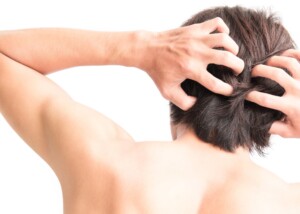
Itchy bumps on the back of your scalp have a specific cause, and thus, a specific solution.
“Itchy bumps on the back of the scalp, called seborrheic folliculitis, are usually a deeper manifestation of ordinary dandruff,” says Neal Schultz, MD, a dermatologist with a private practice in the NYC area, and founder of dermTV.com.
“But instead of it being on the surface of the scalp, it is deep in the hair follicle/oil gland and therefore actually causes bumps which are itchy, and then become crusty both by themselves (as part of the skin’s inflammatory response to the entrapped oil), and also as a result of being scratched, which also causes inflammation.”
The term seborrheic refers to the sebaceous glands, which are the oil glands at issue here. Seborrheic folliculitis is an inflammatory process.
Inflammation means that histamine is released, and this causes the itching. And then you start scratching…
Dr. Schultz explains, “Scratching creates an itch-scratch cycle in which scratching causes inflammation in the skin and a release of histamine which causes more itching, so there’s more scratching and you’re then in an itch-scratch cycle where the itching begets more scratching, and the scratching begets more itching.”
Those itchy bumps on the back of your scalp are on the dandruff continuum, but further down.
The overproduction and entrapment of oil (from the sebaceous glands) in the skin causes dandruff, says Dr. Schultz.
He says to think of the oil as a foreign body, much like a splinter in the skin, with the skin then reacting to this irritant by becoming inflamed, swelling up, to get rid of this invader.
This reactive process causes the flaking (and sometimes redness) that you know as dandruff.
So your scalp (or any other part of your body where this may occur on the skin surface) not only itches, but it has something to show for it: sometimes bumps, or redness, and of course, flaking.
The flaking is caused by the premature shedding of skin cells.
Dr. Schultz explains, “When skin cells fall off at the normal time, they have time to dis-attach from each other, and as individual cells are so small you can’t see them with your naked eye.
But when they fall off prematurely before they have a chance to dis-attach from surrounding skin cells, they fall off as sheets of cells which we see as flakes.”
When this process occurs just at the skin surface, you see dandruff but no bumps on the scalp.
“But when that occurs deeper in the follicle, instead of just flaking red skin, seen in ordinary surface dandruff, you get the actual itchy bumps because there is more inflammation, causing more swelling, hence bumps, which are often crusty and very itchy.
“Itchy because of our friend histamine….whenever there is inflammation, histamine is released and the itching begins.”
What can you do about itchy bumps on the back of your scalp? Dr. Schultz recommends medicated shampoos with one of these active ingredients: salicylic acid, tar, zinc or selenium sulfide. He prefers the ingredients of salicylic acid and tar.
Additionally, says Dr. Schultz, a dermatologist can prescribe a topical cortisone solution to help reduce inflammation and get rid of the itchy bumps on your scalp (or elsewhere).
 Dr. Schultz has been treating his patients’ dermatologic conditions for 30+ years, with particular emphasis in skin cancer prevention and treatment, acne treatment and laser surgery.
Dr. Schultz has been treating his patients’ dermatologic conditions for 30+ years, with particular emphasis in skin cancer prevention and treatment, acne treatment and laser surgery.
 Lorra Garrick has been covering medical, fitness and cybersecurity topics for many years, having written thousands of articles for print magazines and websites, including as a ghostwriter. She’s also a former ACE-certified personal trainer.
Lorra Garrick has been covering medical, fitness and cybersecurity topics for many years, having written thousands of articles for print magazines and websites, including as a ghostwriter. She’s also a former ACE-certified personal trainer.
.









































